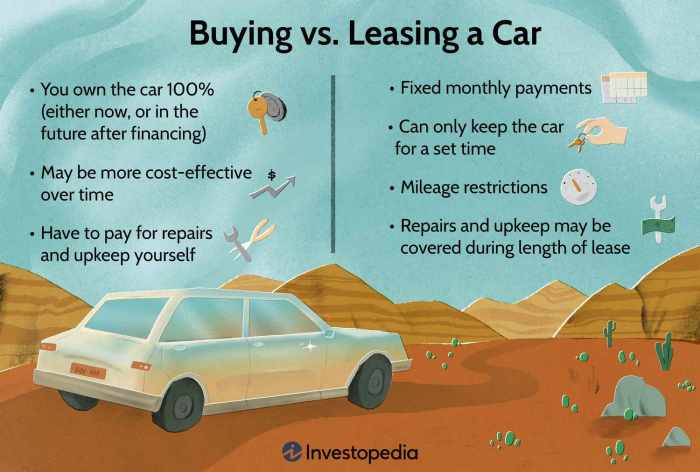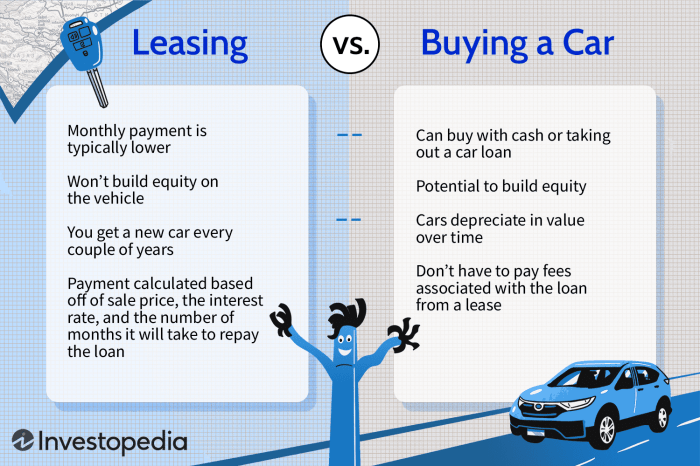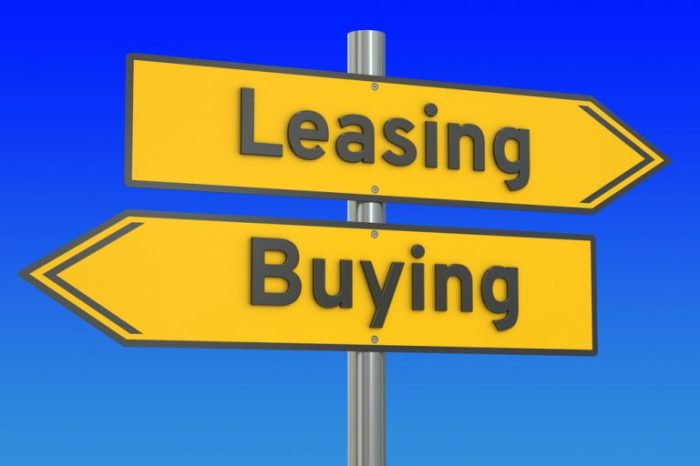Pros and cons of leasing vs buying 2025: Choosing between leasing and buying a car in 2025 is a big decision, impacting your wallet and driving experience for years to come. This guide breaks down the financial, ownership, maintenance, and tax implications of each, helping you make the best choice for your lifestyle and budget. We’ll dive into everything from upfront costs and monthly payments to long-term expenses and the joys (or headaches) of car ownership versus the flexibility of leasing.
From comparing down payments and monthly installments to exploring the nuances of warranties and maintenance responsibilities, we’ll illuminate the key differences between these two popular options. We’ll even look at the resale value and end-of-lease options to give you a comprehensive understanding of the total cost of ownership over time. Ultimately, our goal is to empower you with the knowledge you need to make an informed decision that aligns perfectly with your personal needs and financial goals.
Financial Aspects of Leasing vs. Buying
Choosing between leasing and buying a car in 2025 involves a careful consideration of the financial implications. Both options present different upfront costs, monthly payments, and long-term expenses, impacting your overall budget and financial health. Understanding these differences is crucial for making an informed decision.
Upfront Costs
The initial financial outlay differs significantly between leasing and buying. Purchasing a vehicle typically requires a larger down payment, often ranging from 10% to 20% of the vehicle’s price. Additionally, you might encounter fees for things like document preparation, title transfer, and taxes. Leasing, on the other hand, usually demands a smaller down payment, sometimes as low as 1% or even zero, but may include fees like an acquisition fee, security deposit, and first month’s payment.
For example, buying a $30,000 car might require a $3,000 to $6,000 down payment, while leasing the same car might only need a $300 to $600 down payment plus additional fees. These fees can vary greatly depending on the dealership and the specific terms of the deal.
Monthly Payment Differences
Monthly payments also vary substantially. Loan payments for a purchased vehicle are generally higher than lease payments for the same car, especially in the early years of the loan. This is because you’re paying down the principal and interest over a longer period. Lease payments, however, are based on the vehicle’s depreciation over the lease term, resulting in lower monthly payments.
Let’s consider a hypothetical scenario: A $30,000 car financed over 60 months at a 5% interest rate would result in a higher monthly payment than the same car leased over 36 months with a similar interest rate. Conversely, a lower interest rate (e.g., 3%) would reduce the monthly payments for both loan and lease, but the lease payment would likely remain lower.
The exact figures will vary based on the specific loan and lease terms, credit score, and market conditions in 2025.
Long-Term Financial Implications
The long-term financial implications are where the differences truly stand out. Buying a car allows you to build equity, eventually owning the vehicle outright. However, you’ll also bear the cost of depreciation, which can be substantial, especially in the first few years. Leasing, on the other hand, avoids the burden of depreciation during the lease term. You’re essentially paying for the use of the vehicle, not for its ownership.
So, you’re trying to figure out the whole leasing vs. buying thing for a 2025 car? It’s a total brain-melter, right? One major factor to consider is insurance, and if you’re military, you might snag some sweet deals – check out these Military car insurance discounts 2025 to see how much you could save. That could totally shift the balance in favor of buying, depending on the numbers.
Weighing insurance costs alongside the other pros and cons of leasing versus buying will help you make the best decision.
At the end of the lease, you return the vehicle and have no further financial responsibility. However, you won’t have any equity, and you’ll need to lease or buy another vehicle. The total cost of ownership over several years is typically lower for leasing, especially if you’re not concerned about owning the car outright and prefer regular upgrades.
However, the total cost of ownership can be significantly higher if you exceed the mileage limits or damage the vehicle during the lease term.
Five-Year Total Cost of Ownership Comparison
The following table illustrates a hypothetical comparison of the total cost of ownership over five years for a mid-range sedan in 2025, assuming a purchase price of $30,000. These figures are estimates and will vary based on several factors, including interest rates, depreciation rates, and specific lease and loan terms.
| Year | Lease Payment (estimated) | Loan Payment (estimated) | Depreciation (estimated) |
|---|---|---|---|
| 1 | $450 | $550 | $5,000 |
| 2 | $450 | $550 | $3,000 |
| 3 | $450 | $550 | $2,000 |
| 4 | $450 | $550 | $1,500 |
| 5 | $450 | $550 | $1,000 |
Note: Depreciation is estimated based on average market depreciation rates for similar vehicles. Actual depreciation can vary significantly.
Vehicle Ownership and Usage

Choosing between leasing and buying a car in 2025 hinges significantly on your personal driving habits and long-term plans. Owning a vehicle offers a different set of advantages and disadvantages compared to leasing, primarily revolving around the level of control and long-term commitment involved. Let’s delve into the specifics of vehicle ownership and usage in this decision-making process.Owning a vehicle outright provides significant freedom and flexibility that leasing simply cannot match.
This freedom extends beyond the purely financial aspects discussed earlier.
Ownership Benefits: Customization and Long-Term Use
The most significant advantage of buying a car is the complete freedom to customize and modify it to your liking. Want to install a custom sound system, add a lift kit, or paint it a vibrant shade of electric blue? Go for it! With ownership, the car is yours to personalize as you see fit. This is a stark contrast to leasing, where modifications are often strictly prohibited, and any alterations may incur penalties upon return.
Furthermore, you can keep your vehicle indefinitely. As long as you maintain it, you can drive it for years, even decades, building a sentimental attachment and avoiding the cyclical nature of leasing. This long-term ownership can also be advantageous for resale value; well-maintained vehicles can retain significant value over time, offering a potential financial return when you eventually decide to sell.
Think of classic cars, which often appreciate in value, demonstrating the potential long-term benefits of ownership.
Leasing Limitations: Mileage and Penalties
Leasing, while offering lower monthly payments, often comes with strict mileage limits. Exceeding these limits can result in significant penalties at the end of the lease term, potentially negating any perceived financial savings. For example, a lease agreement might stipulate 12,000 miles per year. Someone who frequently travels for work or enjoys long road trips might easily exceed this limit, incurring hefty charges.
Additionally, leasing agreements often restrict modifications and additions to the vehicle, preventing personalization. You are essentially borrowing the car for a specified period, and any alterations outside of standard wear and tear are subject to penalties. This lack of customization can be a significant drawback for those who value personal expression through their vehicles.
Leasing Advantages: Lower Payments and Frequent Upgrades
The primary appeal of leasing is the lower monthly payments compared to financing a purchase. This can be especially attractive for those with tighter budgets or who prefer to allocate their financial resources elsewhere. Moreover, leasing allows drivers to experience newer vehicle models more frequently. At the end of the lease term, you can simply upgrade to a newer model with the latest features and technology, avoiding the depreciation associated with owning a vehicle for an extended period.
This constant access to cutting-edge technology and safety features is a significant advantage for some drivers. Consider the rapid advancements in automotive technology; leasing allows you to stay ahead of the curve without the large financial commitment of purchasing new vehicles frequently.
Flexibility and Control: Leasing vs. Owning
The following points highlight the differences in flexibility and control between leasing and owning a vehicle:
- Customization: Owning allows complete customization; leasing severely restricts modifications.
- Mileage Limits: Leasing has strict mileage limits with penalties for exceeding them; ownership has no such restrictions.
- Vehicle Lifespan: Ownership allows indefinite vehicle use; leasing is limited to the lease term.
- Long-Term Costs: Owning incurs higher upfront costs but potentially lower overall costs over time; leasing has lower upfront costs but potentially higher overall costs due to multiple lease agreements.
- Equity: Owning builds equity in the vehicle; leasing builds no equity.
Maintenance and Repair Responsibilities: Pros And Cons Of Leasing Vs Buying 2025

Leasing a car versus buying one significantly impacts who’s responsible for keeping it running smoothly. Understanding these differences is crucial for budgeting and avoiding unexpected expenses. This section breaks down the maintenance and repair responsibilities for both leased and purchased vehicles, highlighting key differences in warranty coverage and potential costs.
Generally, lease agreements specify that the lessee (the person leasing the car) is responsible for routine maintenance like oil changes, tire rotations, and fluid top-offs. However, the responsibility for repairs depends on the cause. Wear and tear from normal use is usually the lessee’s responsibility, while repairs due to manufacturer defects are typically covered under warranty. In contrast, car owners are responsible for all maintenance and repairs, regardless of the cause, unless covered by an extended warranty.
Warranty Coverage Comparison
Manufacturers typically offer a basic warranty covering major mechanical components for a set period (usually 3-5 years or a certain mileage limit). This warranty applies to both leased and purchased vehicles. However, the implications differ. For leased vehicles, if a covered repair is needed, the leasing company usually handles the repair, but the lessee might still experience downtime. For purchased vehicles, the owner takes the vehicle to a dealer or mechanic, and the repair process is entirely their responsibility.
Extended warranties, purchased separately, can offer additional protection for both leased and purchased vehicles, though these are typically more expensive.
Lessee Repair Responsibilities and Examples
Lessees are typically responsible for repairs resulting from normal wear and tear. This can include things like replacing worn-out tires, fixing minor dents or scratches (exceeding the lease agreement’s allowance for damage), and addressing damage caused by neglect (e.g., neglecting regular oil changes). For example, if a lessee drives aggressively and wears out the brakes prematurely, they’ll be responsible for the replacement cost.
Another example could be a flat tire caused by running over a curb. The cost of these repairs can vary widely depending on the vehicle and the extent of the damage. A tire replacement might cost between $100 and $300 per tire, while a significant scratch repair could easily exceed $500.
Owner Repair Responsibilities and Examples
Car owners bear the responsibility for all repairs, irrespective of cause, unless specifically covered by an existing warranty. This includes routine maintenance, major repairs (engine failure, transmission issues), and damage caused by accidents or unforeseen circumstances. For instance, an owner might face a $2000 engine repair bill due to a mechanical failure outside of warranty coverage. Another example is a costly transmission overhaul needed due to general wear and tear.
The costs associated with ownership can be significantly higher over the vehicle’s lifespan compared to leasing, as the owner is responsible for all repairs.
Maintenance Responsibility Comparison Table
| Maintenance Item | Lessee Responsibility | Owner Responsibility | Typical Cost |
|---|---|---|---|
| Routine Oil Change | Usually Yes (unless covered under a specific maintenance package) | Yes | $50-$100 |
| Tire Rotation | Usually Yes (unless covered under a specific maintenance package) | Yes | $20-$50 |
| Tire Replacement | Yes (unless due to manufacturer defect) | Yes | $100-$300 per tire |
| Brake Pad Replacement | Yes (unless due to manufacturer defect) | Yes | $100-$300 per axle |
| Major Engine Repair | No (typically covered under warranty, unless misuse) | Yes (unless covered by warranty) | $1000-$5000+ |
| Transmission Repair | No (typically covered under warranty, unless misuse) | Yes (unless covered by warranty) | $2000-$8000+ |
Resale Value and End-of-Term Options
Leasing a car offers a different trajectory of ownership compared to buying, significantly impacting its resale value and the choices available at the lease’s end. Understanding these factors is crucial for making an informed decision. This section will delve into the factors affecting resale value after a lease, the options available to lessees, and their respective financial implications.Factors Influencing Resale Value After a LeaseSeveral factors influence a vehicle’s resale value at the end of a lease.
Mileage is a major one; exceeding the agreed-upon mileage limit drastically reduces the vehicle’s worth. Condition is equally important; scratches, dents, and interior wear and tear all affect the resale price. The vehicle’s make, model, and overall popularity in the used car market also play a role. Finally, the prevailing market conditions – supply and demand for used cars – can significantly impact resale value.
A high-demand vehicle in a seller’s market will fetch a higher price than the same vehicle in a buyer’s market.
So, you’re weighing the pros and cons of leasing vs. buying a car in 2025? A big factor is insurance, especially if you’re a teen. Check out this comparison of State Farm vs Geico rates for teens 2025 to get a better sense of your potential costs. Knowing your insurance budget will definitely help you decide whether the lower monthly payments of leasing or the long-term ownership of buying is the better option for you.
End-of-Lease Options for Lessees
At the lease’s end, lessees typically have three choices: purchasing the vehicle, returning it, or leasing a new one. Each option carries distinct financial implications.
Purchasing the Vehicle
Purchasing the vehicle at the end of the lease, often referred to as the “residual value,” is an option Artikeld in the lease agreement. This residual value is the estimated market value of the vehicle at the lease’s end, and it’s often significantly lower than the original purchase price. Lessees should compare the residual value to the fair market value of similar used vehicles to ensure they aren’t overpaying.
Financing the remaining amount is possible, but it’s crucial to compare interest rates and terms with other loan options.
Returning the Vehicle
Returning the vehicle is the simplest option, requiring only adherence to the lease’s terms concerning mileage and condition. Excess mileage fees can be substantial, and damage beyond normal wear and tear will incur repair costs. While convenient, this option means you won’t own the vehicle.
Leasing a New Vehicle
Many lessees opt to lease a new vehicle, often streamlining the process with the same dealership. This provides access to newer models and technologies, but it continues the cycle of lease payments and doesn’t lead to vehicle ownership.
Financial Implications of End-of-Lease Options, Pros and cons of leasing vs buying 2025
The financial implications of each option vary greatly. Purchasing the vehicle might be financially advantageous if the residual value is significantly lower than the fair market value, allowing for a potentially good deal. Returning the vehicle involves no further financial commitment beyond potential excess mileage or damage fees. Leasing a new vehicle continues the cycle of monthly payments, potentially increasing the total cost of vehicle ownership over time compared to buying and keeping a vehicle.
Depreciation Curve Comparison: Leased vs. Purchased Vehicle
Imagine a graph charting vehicle value against time. Both leased and purchased vehicles depreciate, but the curves differ. The purchased vehicle’s depreciation curve starts high and slopes downward steadily over time. The leased vehicle’s curve starts similarly, but it’s typically truncated at the end of the lease term. The lessee’s financial exposure ends at that point, while the owner continues to bear the depreciation cost.
For example, a $30,000 car might depreciate to $15,000 after three years if purchased. If leased, the lessee might only pay for the depreciation during the lease term, with the remaining depreciation borne by the leasing company or the next lessee. The steepest part of the depreciation curve generally occurs in the first few years of ownership, regardless of whether the vehicle is leased or purchased.
Tax Implications
Leasing and buying a car have distinct tax implications that can significantly impact your overall cost. Understanding these differences is crucial for making an informed financial decision. Factors like your income, tax bracket, and the specific details of your lease or purchase agreement all play a role.The tax treatment of lease payments versus loan payments differs substantially. While lease payments are generally not tax-deductible for personal use vehicles, loan interest payments for purchased vehiclescan* be deductible, although the rules have become more complex in recent years.
Additionally, potential tax credits might be available depending on the type of vehicle purchased, such as those with electric or alternative fuel systems. State and local sales taxes also differ based on whether you lease or buy.
Deductible Loan Interest
For vehicles purchased with a loan, the interest you pay is often partially deductible. However, the amount you can deduct is limited and depends on the total amount of interest paid and your adjusted gross income (AGI). For example, a person with a $30,000 car loan and an AGI of $75,000 might be able to deduct a portion of the interest paid, reducing their taxable income.
The exact amount will depend on the current IRS guidelines and their individual tax situation. This deduction can provide a tangible tax benefit over the life of the loan, offsetting some of the purchase cost. It’s important to consult a tax professional or use tax software to accurately calculate the deduction.
State and Local Sales Taxes
State and local sales taxes vary widely across the United States. When you buy a car, you typically pay sales tax on the purchase price. With a lease, the sales tax is usually included in the monthly payments, although the calculation can vary by state and leasing company. Some states may offer exemptions or reduced rates for certain types of vehicles, such as electric cars.
For instance, California might have a higher sales tax rate than Wyoming, affecting both the purchase and lease scenarios. A person living in a state with a high sales tax rate will experience a larger tax burden regardless of whether they lease or buy, although the timing of the payments will differ.
Tax Credits for Electric Vehicles
The federal government offers tax credits for purchasing new electric vehicles (EVs) and plug-in hybrids. The amount of the credit depends on the vehicle’s battery capacity and manufacturer. For example, a buyer purchasing a qualifying EV might receive a $7,500 federal tax credit, which reduces their tax liability. This credit is applied at the time of filing taxes and can significantly offset the upfront cost of an EV.
However, income limitations and other stipulations might apply, limiting eligibility for some taxpayers. State-level incentives often add to the federal credits, further reducing the overall cost. Someone in a high tax bracket could see a substantial reduction in their tax bill due to this credit, making an EV purchase more financially attractive.
Ultimate Conclusion

So, leasing or buying in 2025? The “best” choice really depends on your individual circumstances. If you value flexibility and lower monthly payments, leasing might be the way to go. But if you prefer long-term ownership, the freedom to customize your ride, and the potential for long-term cost savings, buying might be a better fit. By carefully weighing the pros and cons Artikeld here – from financial implications to maintenance responsibilities and tax considerations – you can confidently navigate the decision and choose the option that best suits your needs and budget.
Happy driving!









